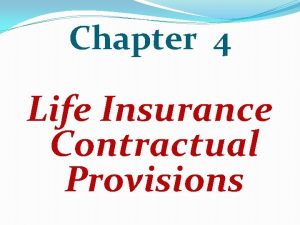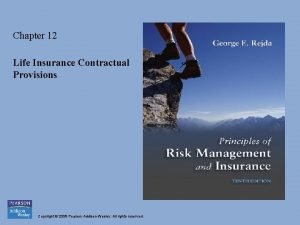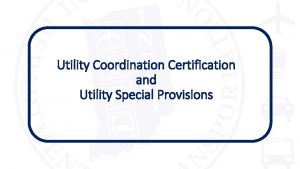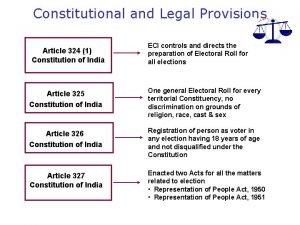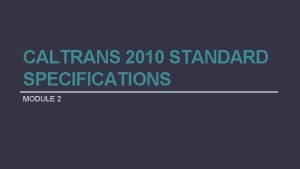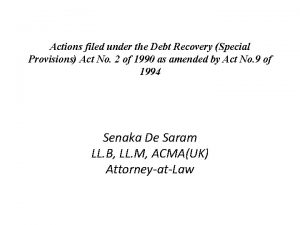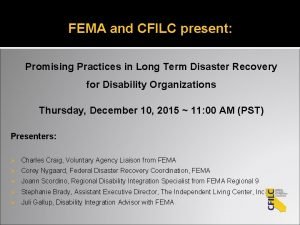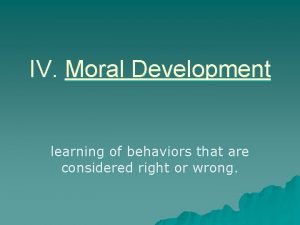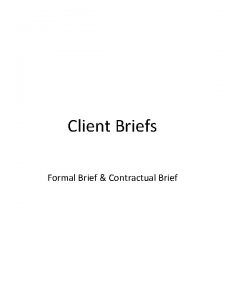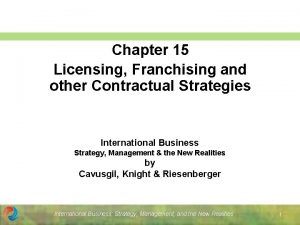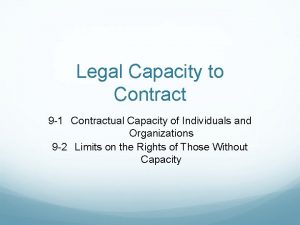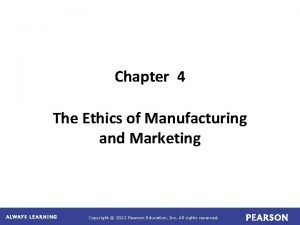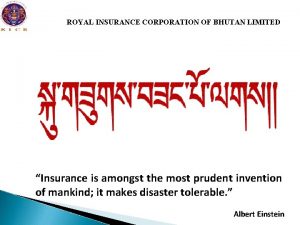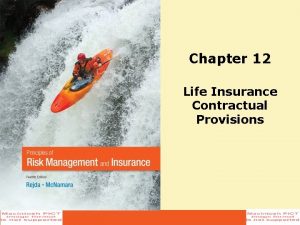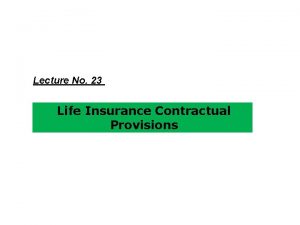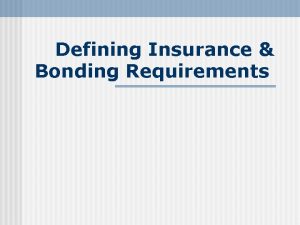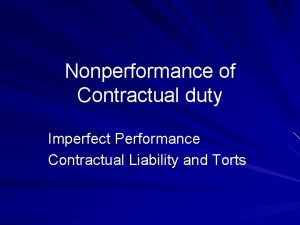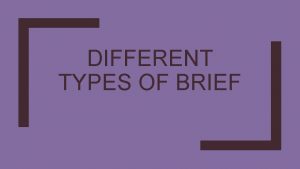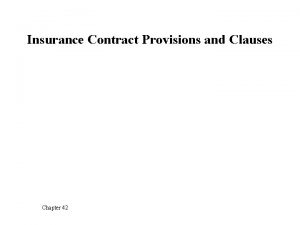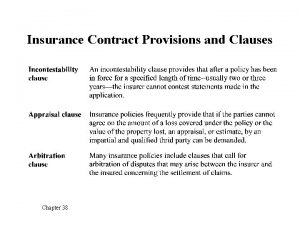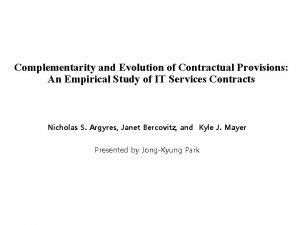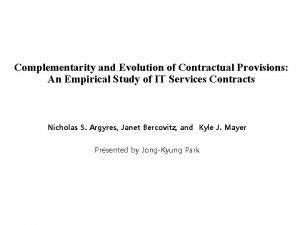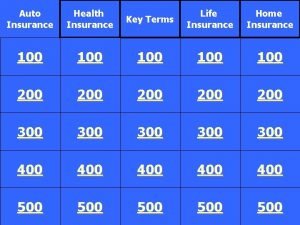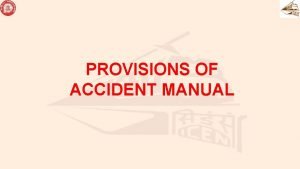Lecture No 24 Life Insurance Contractual Provisions Evaluation
































- Slides: 32

Lecture No. 24 Life Insurance Contractual Provisions

Evaluation of Insurance Methods • Data from National Academy of Social Insurance show that – Private insurers incurred 55 percent – Self-insurers 23 percent – Federal and state funds 22 percent of the cost of workers’ compensation in 2001 • Private insurers are preferred by most employers in states where they’re permitted to operate – Offer the employer an opportunity to insure in one contract all the liabilities likely for damages arising from work-connected injuries – Private insurers offer more certainty in handling out-of-state risks – While the expenses of state funds are somewhat lower than those of private insurers • The difference is not as great as rough comparisons often lead one to believe – Self-insurance has the handicap that it is necessary for the insured to enter the insurance business • Which is essentially unrelated to the insured’s main operations • Also, contributions to a self-insurance fund are often not tax deductible – Experience rating and retrospective rate plans enable large firm to use a private insurer’s facility in transferring as much or as little of the risk as is desired at a modest cost 2

Employment Covered • Compensation laws do not cover all workers – For example, domestic labor and farm labor are often excluded – Employers with only a few employees are excluded under compulsory laws • Only about 9 out of 10 workers are covered • Liability suits are necessary if an excluded worker is to recover anything – Even though a basic purpose of compensation legislation was to eliminate this condition as a prerequisite for employee recoveries • It is a small employer who is excluded from compensation laws and who is most likely to be the object of such suits – This often means that • A successful suit will bankrupt the employer • If the employer is more or less judgment-proof, the injured worker will recover nothing 3

Income Provisions • Compensation laws recognize four types of disability for which income benefits may be paid – Permanent and temporary total disability – Permanent and temporary partial disability • Generally limit payments by specifying the maximum duration of benefits and the maximum weekly and aggregate amounts payable 4

Income Provisions • For permanent total disability benefits, most states permit lifetime payments to the injured worker who is unable to perform the duties of any suitable occupation • In the remaining states, typical limitation is between 400 and 500 weeks of payments – There is often a limitation on the aggregate amount payable • A common limitation that income benefits cannot exceed about 2/3 of the worker’s average weekly wage or some dollar amount • Weekly benefits for temporary total disability are usually the same as for permanent total disability – Except that often there is a lower maximum aggregate limitation and a shorter time duration for such payments • Most workers’ compensation laws specify the lump sums may be paid to a worker as liquidating damages for a disability – Such as the loss of a leg or an eye • Loss is permanent but does not totally incapacitate the worker 5

Survivor Benefits • In the case of fatal injuries, the widow or widower and children of the worker are entitled to funeral and income benefits – Subject to various limitations • The maximum benefits to the widow or widower are generally less than they would have been to the disabled worker – But if the survivor has children, these benefits are comparable to what the worker would have received for permanent total disability • Highway crashes represent the single largest cause of workplace deaths – Accounting for ¼ of all fatalities in workers’ compensation 6

Medical Benefits • Most workers’ compensation laws provide relatively complete medical services to an injured worker – Including allowances for certain occupational diseases • In all jurisdictions unlimited medical care is provided for accidental work injuries – And broad coverage for occupational disease is provided 7

Rehabilitation Benefits • Provided by most states • Generally recognized that the quantity and quality of the services are subject to wide variation • Federal Vocational Rehabilitation Act includes federal funds to aid states in vocational rehabilitation of individuals who are injured in the workplace 8

Benefits • There is great variability between the states • Table 12 -1 shows descriptive statistics for some states • A Federal Employees Compensation plan covers federal employees – It has the highest benefit of any plan 9

Table 12 -1: State Workers’ Compensation Provisions 10

Experience Rating • Widely used in workers’ compensation insurance • General theory is that an employer has some control over the loss ratio and is entitled to a credit for good loss record – Or should pay a higher rate if the loss record is poorer than average • The details of the plan are very complex – General procedure is to determine, for each occupational class, some expected loss ratio against which the insured’s actual loss ratio is compared • Not all losses suffered by an insured are counted – The plan uses a stabilizing factor so that unusually large losses cannot operate to increase the small employer’s rate unreasonably – For the large employer, the employer’s loss experience becomes more important as its expected losses become greater • Experience rating in workers’ compensation gives employers an incentive to do whatever is within their control to prevent accidents 11

Retrospective Rating • Entirely voluntary agreement between the insured and the insurer • If the employer’s payroll is such that a standard of premium of $1, 000 or more is incurred – Is considered that the firm is large enough to develop experience that is partially credible • Standard premium is defined as what the employer would have paid at manual rates after adjustment for experience rating – But before any adjustment for retrospective rating • In practice, an employer likely to use retrospective rating is generally considerably larger than this 12

Retrospective Rating • There are various plans of retrospective rating – The employer must choose one – Which plan should the employer choose? • Essentially, this question reduces to one of how much risk the employer is willing to assume • The basic retrospective rating formula is given by – R = [BP + (L)(LCF)]TM • • R = retrospective premium payable for the year in question BP = a basic premium designed to cover fixed costs of the insurer L = losses actually suffered by the employer LCF = loss conversion factor designed to cover the variable cost of the insurer • TM = tax multiplier designed to reflect the premium tax levied by the state of the insurer’s business – The basic premium declines as the size of the employer increases • Differs with the type of plan used – The formula is subject to the operation of certain minimums and maximums • Both of which decline as the size of the employer increases 13

Risk Management and Workers’ Compensation • Workers’ compensation is one of the most frequently self-insured coverages in the risk management area • Characterized by relatively high-frequency and low-severity losses • In recent years, the motivation to selfinsure a portion or all of this exposure has increased – Due to rapidly rising premium levels • When premiums are high, the cash flow benefits of self-insurance are greater – Self-insurance becomes more attractive 14

Factors Favoring Self-Insurance • Lower administrative expenses – When a firm establishes a self-insured workers’ compensation program, it eliminates most of the premium paid to an insurer • Cash flow benefits – Probably greater than the cost saving aspects of selfinsuring workers’ compensation – Under a traditional insured plan, the insured pays the premium • And at some later date the insurer pays all the claims – In the aggregate, this arrangement provides the insurance company with a large amount of money that can be invested in income-producing securities until the claims are paid – When a firm self-insurers, it holds the money until the claims are paid • As it takes several years to pay all the claims from a given year’s loss exposure – The self-insurer has the use of some of the funds for a fairly long time – There’s a perpetual sum available for investment in securities or in the self-insured’s own operations 15

Factors Favoring Self-Insurance • Claims-conscious management – Management often becomes more claims conscious when it is paying directly for workers’ compensation losses – When insurers are paying the claims, only an indirect effect is seen by operating managers – As a consequence, workers’ compensation losses often decline when a firm initiates a selfinsurance program 16

Factors Against Self-Insurance • Size of firm – A company must be financially capable of retaining selfinsured losses – It must have a large enough exposure so that it can predict much of its losses – Generally, a firm with an annual premium of less than $250, 000 will not self-insure • Stability of workforce – Concerns how much turnover of the firm has and how rapidly it is expanding – Newly employed people, as well as younger employees, have higher accident rates than more mature workers – New plants tend to have higher accident rates than established ones 17

Factors Against Self-Insurance • Tax consequences – Under a self-insured program, one cannot take a tax deduction until the funds are actually paid • Availability of services – When a firm self-insures, it must provide or purchase services that were formally provided by the insurance company – These services include • Loss control activities, claims adjusting, data processing, and program administration – A firm can usually buy these services from companies that specialize in such activities 18

Excess Insurance • Most companies do not completely self-insure the workers’ compensation exposure – Because of the catastrophic nature of certain types of workers’ compensation losses – Such claims as long-term disability or death may add up to hundreds of thousands of dollars • To prevent such circumstances, self-insurers purchase excess insurance • Basic types of excess insurance – Specific • The self-insurer absorbs the first x dollars on any loss – Aggregate excess • The policy operates like an aggregate deductible • Typically, the aggregate limit is at least the level of what the workers’ compensation premiums would have been if insurance had been purchased 19

Potential Problems • Problems include, but are not limited to – Financial ability to retain losses – A large enough exposure base to be able to predict losses accurately – Actual management of the plan – Establishment of a loss prevention and protection program – Management of a risk management information system – Availability of excess-of-loss insurance – Top management commitment to the plan 20

Alternative Workers’ Compensation Risk Financing Strategies • Various financing plans for workers’ compensation programs often use a letter of credit issued by a financial institution on behalf of the insured • By using this approach, an insured obtains maximum cash flow and tax benefits • However, there are caveats that need to be considered – Each year a letter of credit must be issued • Letters of credit cost money and they’re more expensive than they used to be – The firm’s overall debt limit could be adversely affected – IRS is taking a tougher position on plans where the insured tries to take a tax deduction for the full premium but pays only a small part in cash 21

Alternative Workers’ Compensation Risk Financing Strategies • Alternative financing strategies include such programs as – Investment credit • Require one to pay the full premium in cash at the beginning of the year, but give the insured investment earnings from the premiums – Compensating balance • Reduce the firm’s obligations to banks that lend money to the insured 22

Captive Insurance Companies • General, auto, and product liability cases can give rise to large awards – For example, Domino’s Pizza, Inc. , lost a lawsuit concerning an auto accident in which one of its delivery persons ran a red light and injured someone • Part of the evidence involved Domino’s promise to deliver pizza in 30 minutes and that drivers were not driving in a reasonable manner • The jury returned a verdict for $78 million – A captive insurance arrangement would have been useful in financing the loss 23

Special Tax Status of Insurance Companies • Insurance companies are the only type of company that can establish loss reserves and take a tax deduction for the loss’s accrual • Other corporations can take tax deductions for loss only after the loss has been paid • Insurance companies can pre-fund losses with pretax dollars – A manufacturer must use after-tax dollars • If a risk manager could create an insurance company or an organization that would pass the IRS definition of an insurance company – Pretax dollars could be used to fund self-insured losses of his or firm 24

Operation of a Captive • Captive insurer – A subsidiary formed by a company that is called a parent • It is a captive of the parent because the parent controls it • Captive insurance companies became very popular in the 1960 s and 1970 s • A firm paid a premium to the subsidiary and took the deduction – The captive recorded the premium as revenue and increased its loss reserve by almost an equal amount • So the captive did not show a profit – Resulted in a 100 percent tax deduction for the parent • The captive held the funds; it did not earn a profit, so did not pay any income taxes • IRS began to challenge this arrangement in the courts – Rule slowly involved that a parent could not take the deduction unless a subsidiary had a significant amount of non-related risks • The rule required a significant number of exposures that were not part of the parent organization 25

Onshore Versus Offshore Captives • Creating a captive insurance company in the United States is not a difficult task – But it is relatively expensive • Most states have minimum capital requirements that can run as high as several million dollars • An onshore captive is subject to the state laws in which it is incorporated • However offshore captives are not subject to such restrictive regulatory laws – Little upfront money is needed to start offshore captives – Offshore captives have very favorable income tax laws 26

Other Attributes of Captives • When a firm writes its insurance in a captive – It can write the policy exactly the way it wishes • Often the risk manager of the parent firm is the CEO of the captive – So the parent can make the insurance policy as liberal as it desires • For some firms that have sought to manage risk on a broader enterprise-wide basis – Captives have offered a useful tool for financing risks that have not traditionally been addressed in the insurance market • Such risks include reputation risk, branded risk, residual value risk on vehicle leases, and weather risk • In 2003 some firms begin to fund employee benefits through their captives 27

Other Attributes of Captives • Regulatory restraints on investments are less – Captive can invest its funds almost any way it wishes • Captive insurance companies can have direct contact with reinsurers • It is through reinsurance that captives can serve as a funding vehicle for self-insured plans and reduce the probability of catastrophic losses 28

Potential Problems of Captives • Demand time and energy of the risk manager • Require the firm to incorporate the captive either on- or offshore – Which takes time and money • The firm must have enough of a loss exposure to warrant these expenses – For this reason companies often group together to form association or industry captives • If a parent creates a single-owner captive the tax deductibility of payments will be problematic – IRS may require a substantial amount of unrelated business • One advantage of the association or industry captive is that it has diverse ownership and insures a significant amount of unrelated business 29

Potential Problems of Captives • Hard reinsurance markets may make it difficult for the captive to reinsure its business – Without reinsurance, the captive can be a very dangerous undertaking • Sometimes it is difficult for the risk manager to justify the continued use of a captive in extremely soft markets – The temptation may arise to shut down the captive because insurance is so cheap – However, it is important for the risk manager to have continuity in his or her own risk management program • Changing from insurance to a captive and then back again can break the continuity of the plan and cost more money • Financial officers often dislike captives because once money is placed or funds accumulate in a captive – It is difficult to obtain the money except for risk management purposes • Table 12 -5 shows the most popular locations for captive insurance companies 30

Table 12 -5: Most Popular Locations for Captive Insurance Companies, 2002 31

End of Lecture 24
 Life insurance contractual provisions
Life insurance contractual provisions Life insurance contractual provisions
Life insurance contractual provisions Life insurance contractual provisions
Life insurance contractual provisions 01:640:244 lecture notes - lecture 15: plat, idah, farad
01:640:244 lecture notes - lecture 15: plat, idah, farad Nature of fire insurance
Nature of fire insurance Utility coordination
Utility coordination Note 3 ways war affected the land
Note 3 ways war affected the land Legal provisions
Legal provisions Caltrans revised standard plans
Caltrans revised standard plans Debt recovery special provisions act
Debt recovery special provisions act Does fidelity offer trust services
Does fidelity offer trust services Provisions of fema act 1999
Provisions of fema act 1999 New hobbs farm and provisions
New hobbs farm and provisions 2015 nehrp recommended seismic provisions
2015 nehrp recommended seismic provisions Common provisions regulation
Common provisions regulation Define ethics
Define ethics Formales brief
Formales brief Licensing franchising and other contractual strategies
Licensing franchising and other contractual strategies This type of work
This type of work Cargador porteador y consignatario
Cargador porteador y consignatario Contractual savings institutions
Contractual savings institutions Community pharmacy contractual framework
Community pharmacy contractual framework The rules of a contractual relationship chapter 8
The rules of a contractual relationship chapter 8 Contractual rights
Contractual rights Nhs community pharmacy contractual framework
Nhs community pharmacy contractual framework Contractual risk transfer in construction
Contractual risk transfer in construction Contractual capacity is the ability to
Contractual capacity is the ability to Due care theory
Due care theory Marco contractual
Marco contractual Contractual capacity
Contractual capacity Life lecture meaning
Life lecture meaning Insurance company in bhutan
Insurance company in bhutan Desjardins assurance
Desjardins assurance
